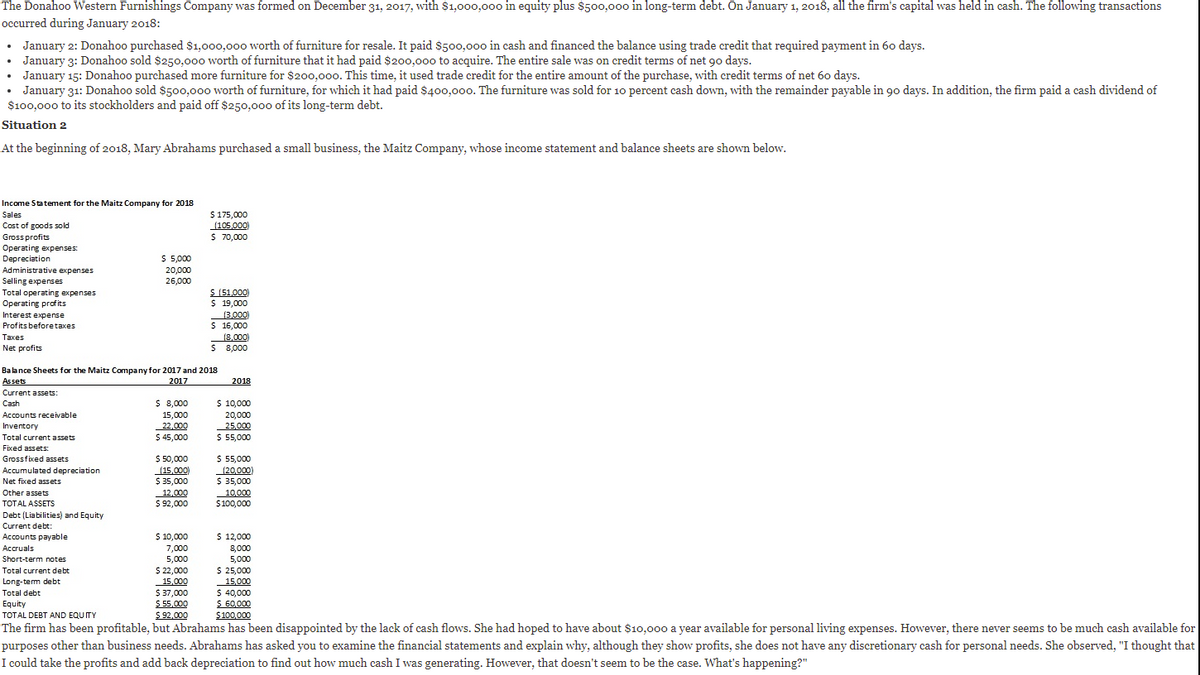Given the information provided by the financial statements in Situation 2, what would you tell Abrahams? (As part of your answer, calculate the firm's cash flows.)
Given the information provided by the financial statements in Situation 2, what would you tell Abrahams? (As part of your answer, calculate the firm's cash flows.)
Excel Applications for Accounting Principles
4th Edition
ISBN:9781111581565
Author:Gaylord N. Smith
Publisher:Gaylord N. Smith
Chapter14: Statement Of Cash Flows (cashflow)
Section: Chapter Questions
Problem 1R: The comparative balance sheet of Prime Sports Gear, Inc., at December 31, the end of the fiscal...
Related questions
Question
Given the information provided by the financial statements in Situation 2, what would you tell Abrahams? (As part of your answer, calculate the firm's cash flows.)

Transcribed Image Text:The Donahoo Western Furnishings Company was formed on December 31, 2017, with $1,000,0oo in equity plus $500,000 in long-term debt. On January 1, 2018, all the firm's capital was held in cash. The following transactions
occurred during January 2018:
• January 2: Donahoo purchased $1,000,000 worth of furniture for resale. It paid $500,000 in cash and financed the balance using trade credit that required payment in 60 days.
• January 3: Donahoo sold $250,000 worth of furniture that it had paid $200,000 to acquire. The entire sale was on credit terms of net 90 days.
• January 15: Donahoo purchased more furniture for $200,000. This time, it used trade credit for the entire amount of the purchase, with credit terms of net 60 days.
January 31: Donahoo sold $500,000 worth of furniture, for which it had paid $400,000. The furniture was sold for 10 percent cash down, with the remainder payable in 90 days. In addition, the firm paid a cash dividend of
$100,000 to its stockholders and paid off $250,000 of its long-term debt.
Situation 2
At the beginning of 2018, Mary Abrahams purchased a small business, the Maitz Company, whose income statement and balance sheets are shown below.
Income Statement for the Maitz Company for 2018
$ 175,000
(105,000
$ 70,000
Sales
Cost of goods sold
Gross profits
Operating expenses:
Depreciation
Administrative expenses
Selling expenses
Total operating expenses
Operating profits
Interest expense
Profits before taxes
$ 5,000
20,000
26,000
S (51,000
$ 19,000
(3,000
$ 16,000
(8,000)
$ 8,000
Taxes
Net profits
Balance Sheets for the Maitz Company for 2017 and 2018
Assets
2017
2018
Current assets:
Cash
$ 8,000
$ 10,000
Accounts receivable
15,000
22,000
$ 45,000
20,000
25,000
Inventory
Total current assets
$ 55,000
Fixed assets:
$ 50,000
(15,000
$ 35,000
12,000
$ 92,000
$ 55,000
(20,000)
$ 35,000
10,000
$100,000
Grossfixed assets
Accumulated depreciation
Net fixed assets
Other assets
TOTAL ASSETS
Debt (Liabilities) and Equity
Current debt:
Accounts payable
$ 10,000
$ 12,000
8,000
5,000
$ 25,000
Accruals
7,000
5,000
$ 22,000
15,000
$ 37,000
$ 55,000
$ 92,000
Short-term notes
Total current debt
Long-tem debt
15,000
$ 40,000
S 60,000
$100,000
Total debt
Equity
TOTAL DEBT AND EQUITY
The firm has been profitable, but Abrahams has been disappointed by the lack of cash flows. She had hoped to have about $10,000 a year available for personal living expenses. However, there never seems to be much cash available for
purposes other than business needs. Abrahams has asked you to examine the financial statements and explain why, although they show profits, she does not have any discretionary cash for personal needs. She observed, "I thought that
I could take the profits and add back depreciation to find out how much cash I was generating. However, that doesn't seem to be the case. What's happening?"
Expert Solution
This question has been solved!
Explore an expertly crafted, step-by-step solution for a thorough understanding of key concepts.
This is a popular solution!
Trending now
This is a popular solution!
Step by step
Solved in 2 steps

Knowledge Booster
Learn more about
Need a deep-dive on the concept behind this application? Look no further. Learn more about this topic, accounting and related others by exploring similar questions and additional content below.Recommended textbooks for you

Excel Applications for Accounting Principles
Accounting
ISBN:
9781111581565
Author:
Gaylord N. Smith
Publisher:
Cengage Learning

Financial Accounting
Accounting
ISBN:
9781305088436
Author:
Carl Warren, Jim Reeve, Jonathan Duchac
Publisher:
Cengage Learning

Excel Applications for Accounting Principles
Accounting
ISBN:
9781111581565
Author:
Gaylord N. Smith
Publisher:
Cengage Learning

Financial Accounting
Accounting
ISBN:
9781305088436
Author:
Carl Warren, Jim Reeve, Jonathan Duchac
Publisher:
Cengage Learning